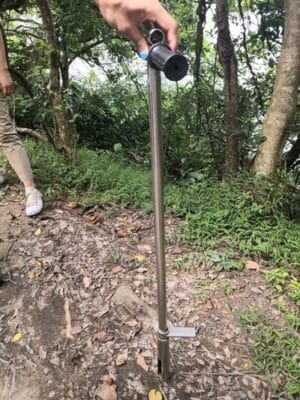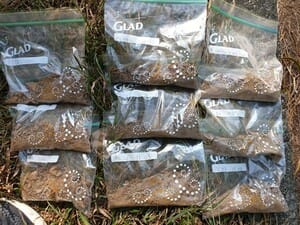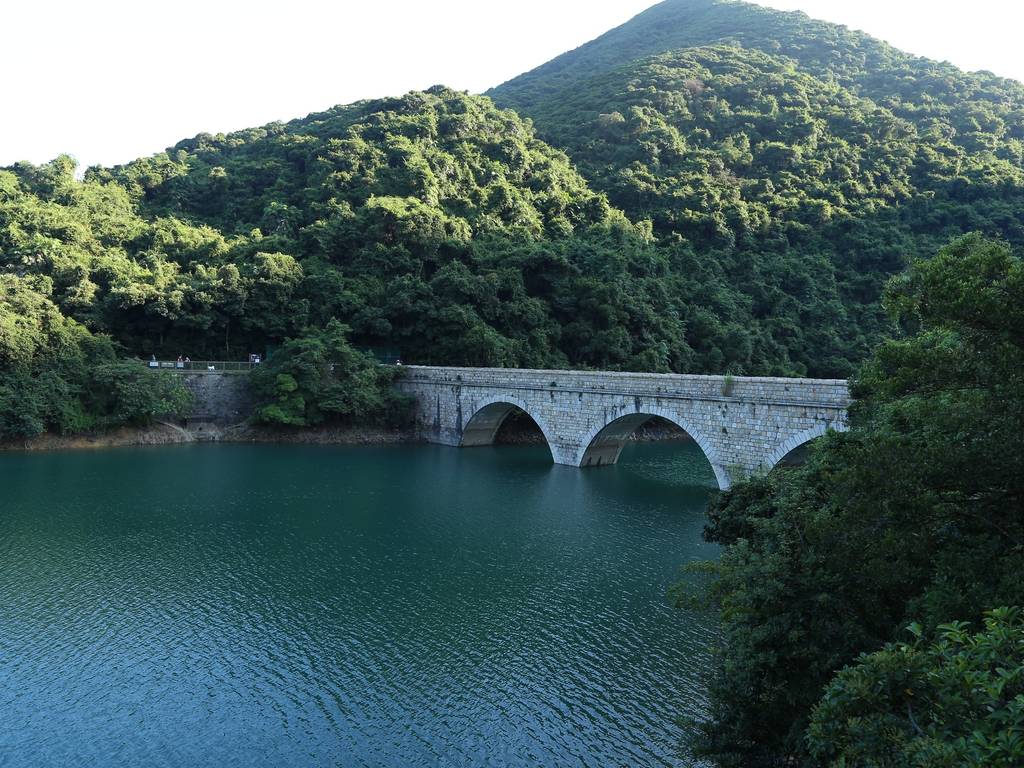倪琼華博士, 建造、環境及工程學系
Country parks play an important role in nature protection, recreation, and outdoor education. During weekends and holidays, thousands of Hong Kong residents and tourists flock to country parks for camping and hiking. Hong Kong is a densely populated city. Most country parks in Hong Kong are adjacent to busy roads, meaning that the soil may be polluted with heavy metals emitted from the traffic activities nearby. This can pose potential health risks to the park users especially children when visiting the parks, as well as ecological risks to the environment (i.e., biological, chemical or physical stress which can have an adverse response in the environment).
There are twenty-four designated country parks in Hong Kong. Dr Edith Ngai from the Department of Construction Technology and Engineering studied four country parks, namely Plover Cove Country Park, Sai Kung West Country Park, Lion Rock Country Park, and Kam Shan Country Park. These selected parks are near busy roads, and people who engage in recreational activities are most vulnerable to the effects of pollution, so it is necessary to study the potential health impact of soil pollution on these sites.
Between the wet (Apr to Oct) and dry (Nov to Mar) seasons from 2019 and 2021, 48 topsoil samples were collected from the four country parks. At each location, a stainless-steel soil sample probe was used to collect 0-10 cm of topsoil samples.
 使用土壤樣品探針採集土壤樣本
這些土壤樣本被送到香港認可化驗所進行分析。利用電感耦合等離子體質譜 (ICP-MS) 或電感耦合等離子體原子發射 (ICP-AES) 來檢測樣品中是否含砷、銀、鎘、鉻、銅、汞、鎳、鉛和鋅等重金屬。研究團隊使用「污染負荷指數 (PLI)」 、「平均污染指數 (PIave)」 、「Nemerow污染指數 (PINemerow)」 等幾個指數來評估土壤樣本的污染程度,透過比較這些指數來評估不同地點的整體土壤質量。
使用土壤樣品探針採集土壤樣本
這些土壤樣本被送到香港認可化驗所進行分析。利用電感耦合等離子體質譜 (ICP-MS) 或電感耦合等離子體原子發射 (ICP-AES) 來檢測樣品中是否含砷、銀、鎘、鉻、銅、汞、鎳、鉛和鋅等重金屬。研究團隊使用「污染負荷指數 (PLI)」 、「平均污染指數 (PIave)」 、「Nemerow污染指數 (PINemerow)」 等幾個指數來評估土壤樣本的污染程度,透過比較這些指數來評估不同地點的整體土壤質量。
 土壤樣本
結果顯示公路邊的土壤表面因交通活動而受重金屬污染,重金屬濃度並隨著交通量而增加。其中金山郊野公園的鉻、銅、鉛和鋅濃度最高, 比其他三個公園的平均濃度高出 7.8 倍。 而 PIave 和 PINemerow 指數顯示,金山郊野公園的土壤污染程度指數在四個郊野公園中亦排行最高 (見表一) 。在土壤狀況方面,污染負荷指數(PLI)顯示除了船灣郊野公園外,其餘的三個郊野公園的土壤狀況都隨著時間的推移而惡化,而導致惡化的原因就是交通量增加。
土壤樣本
結果顯示公路邊的土壤表面因交通活動而受重金屬污染,重金屬濃度並隨著交通量而增加。其中金山郊野公園的鉻、銅、鉛和鋅濃度最高, 比其他三個公園的平均濃度高出 7.8 倍。 而 PIave 和 PINemerow 指數顯示,金山郊野公園的土壤污染程度指數在四個郊野公園中亦排行最高 (見表一) 。在土壤狀況方面,污染負荷指數(PLI)顯示除了船灣郊野公園外,其餘的三個郊野公園的土壤狀況都隨著時間的推移而惡化,而導致惡化的原因就是交通量增加。
表一. 香港四個郊野公園的綜合污染指數概要 in Hong Kong
Overall, the results suggest that the ecological risks in all the parks were acceptable, ranging from low to moderate. Dr Ngai outlines that developing better urban planning can avoid high ecological risks, and to reduce heavy metal pollution in country parks, increasing the height of roadside green plants is a solution.
From this study, it is clear that traffic-induced pollution is present on the soil surface of Hong Kong’s country parks. At present, there are no regulatory guidelines and benchmarks for assessing metal pollution in the soils in Hong Kong. Existing guidelines in the industry only focus on the impact of heavy metal pollution from industrial facilities without acknowledging pollution from traffic activities. With many high-polluting industries gradually leaving Hong Kong, vehicular emissions will become the main source of environmental pollution. More research is needed to address the problem of traffic-induced pollution, including research on emission control measures in areas with busy traffic activities to reduce traffic-induced heavy metal pollution.
(Acknowledgement: This project was supported by the THEi Seed Grant Scheme, Project No.: SG1819106.)
 使用土壤樣品探針採集土壤樣本
這些土壤樣本被送到香港認可化驗所進行分析。利用電感耦合等離子體質譜 (ICP-MS) 或電感耦合等離子體原子發射 (ICP-AES) 來檢測樣品中是否含砷、銀、鎘、鉻、銅、汞、鎳、鉛和鋅等重金屬。研究團隊使用「污染負荷指數 (PLI)」 、「平均污染指數 (PIave)」 、「Nemerow污染指數 (PINemerow)」 等幾個指數來評估土壤樣本的污染程度,透過比較這些指數來評估不同地點的整體土壤質量。
使用土壤樣品探針採集土壤樣本
這些土壤樣本被送到香港認可化驗所進行分析。利用電感耦合等離子體質譜 (ICP-MS) 或電感耦合等離子體原子發射 (ICP-AES) 來檢測樣品中是否含砷、銀、鎘、鉻、銅、汞、鎳、鉛和鋅等重金屬。研究團隊使用「污染負荷指數 (PLI)」 、「平均污染指數 (PIave)」 、「Nemerow污染指數 (PINemerow)」 等幾個指數來評估土壤樣本的污染程度,透過比較這些指數來評估不同地點的整體土壤質量。
 土壤樣本
結果顯示公路邊的土壤表面因交通活動而受重金屬污染,重金屬濃度並隨著交通量而增加。其中金山郊野公園的鉻、銅、鉛和鋅濃度最高, 比其他三個公園的平均濃度高出 7.8 倍。 而 PIave 和 PINemerow 指數顯示,金山郊野公園的土壤污染程度指數在四個郊野公園中亦排行最高 (見表一) 。在土壤狀況方面,污染負荷指數(PLI)顯示除了船灣郊野公園外,其餘的三個郊野公園的土壤狀況都隨著時間的推移而惡化,而導致惡化的原因就是交通量增加。
土壤樣本
結果顯示公路邊的土壤表面因交通活動而受重金屬污染,重金屬濃度並隨著交通量而增加。其中金山郊野公園的鉻、銅、鉛和鋅濃度最高, 比其他三個公園的平均濃度高出 7.8 倍。 而 PIave 和 PINemerow 指數顯示,金山郊野公園的土壤污染程度指數在四個郊野公園中亦排行最高 (見表一) 。在土壤狀況方面,污染負荷指數(PLI)顯示除了船灣郊野公園外,其餘的三個郊野公園的土壤狀況都隨著時間的推移而惡化,而導致惡化的原因就是交通量增加。
| PLI | PIave | PI(Nemerow) | RI (生態風險指數) | |
| 船灣郊野公園 | 0.99 | 1.08 | 1.81 | 70.78 |
| 西貢西郊野公園 | 2.84 | 1.22 | 1.47 | 67.35 |
| 獅子山郊野公園 | 4.11 | 1.34 | 1.96 | 98.84 |
| 金山郊野公園 | 813 | 3.95 | 8.60 | 192.08 |

